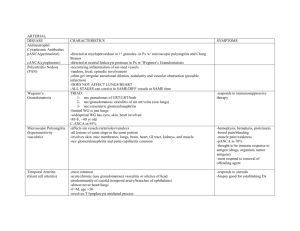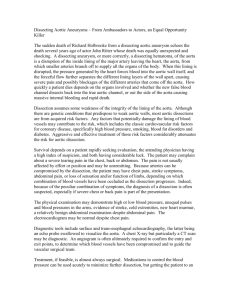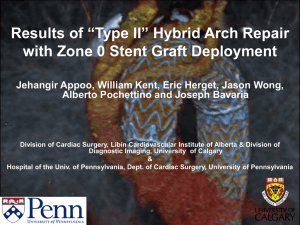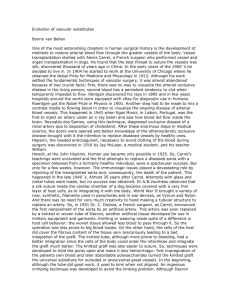The aortic arches
advertisement
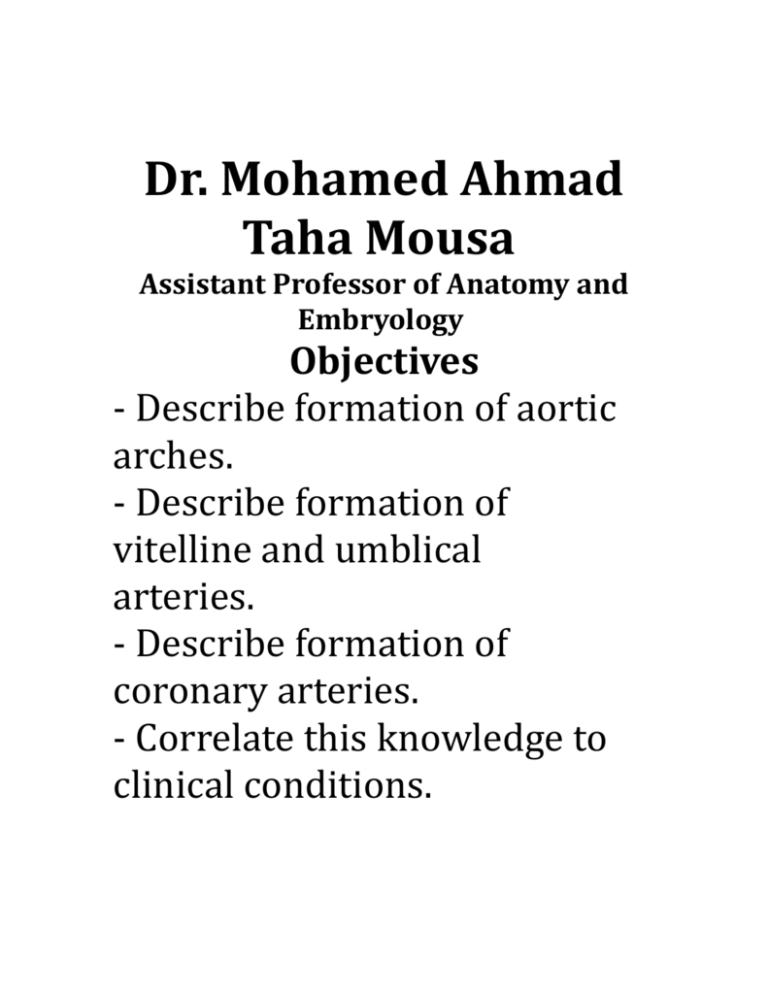
Dr. Mohamed Ahmad Taha Mousa Assistant Professor of Anatomy and Embryology Objectives - Describe formation of aortic arches. - Describe formation of vitelline and umblical arteries. - Describe formation of coronary arteries. - Correlate this knowledge to clinical conditions. Aortic arches The pharyngeal arches: It is formed during the 4th - 5th weeks of development. - Each arch receives its own cranial nerve and artery. The aortic arches: It arises from the aortic sac (the most distal part of the truncus arteriosus) and terminates in the right and left dorsal aortae. - The aortic arches are embedded in the mesenchyme of the pharyngeal arches. The aortic sac: It contributes a branch to each new pharyngeal arch so it is giving rise to total of 6 pairs of arteries. - The 5th arch is not formed or incompletely formed and then regresses. The dorsal aortae: It remains paired in the region of the arches but caudal to this region they fuse to form a single vessel. Fate of the aortic sac: It forms right and left horns giving rise to: - Brachiocephalic artery - Proximal segment of the arch of aorta respectively. Fate of the aortic arches: - The 1st aortic arch: It disappeared and a small portion persists to form the maxillary artery. - The 2nd aortic arch: It disappeared and a small portions persists to form the hyoid and stapedial arteries. - The 3rd aortic arch: It forms the common carotid, external carotid artery and the first part of internal carotid artery. - The remaining part of the internal carotid is formed by the cranial portion of dorsal aorta. - The 4th aortic arch: It persists on both sides but its fate is different on the right and left sides. - On the left side: It forms part of the arch of the aorta (between the left common carotid and the left subclavian arteries). - On the right side: It forms the most proximal segment of the right subclavian artery while the distal part is formed by a portion of the right dorsal aorta and the 7th intersegmental artery. - The 5th aortic arch: It is never formed or incompletely formed and then regresses. - The 6th aortic arch: It is known as the pulmonary arch, it gives an important branch that grows toward the developing lung bud. - On the right side: - The proximal part becomes the proximal segment of the right pulmonary artery. - The distal portion of this arch loses its connection with the dorsal aorta and disappears. - On the left side: The proximal part form the left pulmonary artery and distal part persists during intrauterine life as the ductus arteriosus. Other changes occurs in the aortic arches: 1. The dorsal aorta between the 3rd and 4th arches is obliterated. 2. The right dorsal aorta between the 7th intersegmental artery and the junction with the left dorsal aorta disappears. 3. Growth of the forebrain and elongation of the neck pushing the heart into the thoracic cavity. - The carotid, brachiocephalic arteries elongate and the left subclavian artery is fixed in the arm at the origin of the left common carotid artery. 4. The course of the recurrent laryngeal nerves becomes different: - On the right side: The distal part of 5th and 6thaortic arch disappear so the nerve hooks around the right subclavian artery. - On the left side: The 6th aortic arch persists so the nerve hooks around the arch of aorta. Vitelline arteries - It is a number of paired vessels supplying the yolk sac and it is gradually fuses and form the arteries in the dorsal mesentery of the gut. Derivatives in adult: They are represented by the celiac and superior mesenteric arteries. - The inferior mesenteric artery is derived from the umbilical arteries. - These 3 vessels supply derivatives of the foregut, midgut and hindgut respectively. Umbilical arteries - They are paired branches of the dorsal aorta in the placenta. - During the 4thweek each artery is connected with the dorsal branch of aorta (common iliac artery) and loses its earliest origin. Derivatives: - The proximal part of the artery persist as internal iliac and superior vesical arteries - The distal parts form the medial umbilical ligaments. Coronary arteries - They are derived from two sources: 1. Angioblasts: It is formed from the sinus venosus that are distributed over the heart surface by cell migration. 2. Epicardium: Some epicardial cells undergo an epithelial to mesenchymal transition induced by the underlying myocardium. - The newly formed mesenchymal cells: Contribute to endothelial and smooth muscle cells of the coronary arteries. - Connection of the coronary arteries to the aorta: It occurs by ingrowth of arterial endothelial cells from the arteries into the aorta. Clinical applications 1. Patent ductus arteriosus: It is one of the most frequent abnormalities. - It is more common in pre mature. - It may be single or with heart defects. 2. Coarctation of the aorta: It is congenital narrowing of the arch of aorta. - It may be preductal or postductal (the most common type). 3. Abnormal origin of the subclavian artery: - It occurs when the artery develops from distal portion of right dorsal aorta and 7th intersegmental artery. 4. Double aortic arch: The right dorsal aorta persist between the 7th intersegmental artery and its junction with the left dorsal aorta. 5. Right aortic arch: The left 4th aortic arch and left dorsal aorta are obliterated and replaced by corresponding vessels in the right side.

